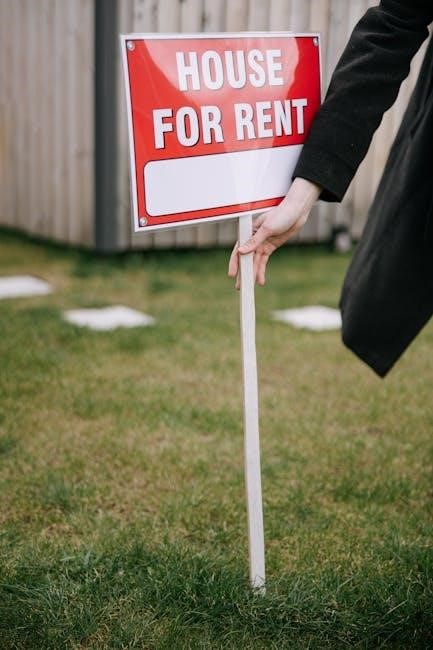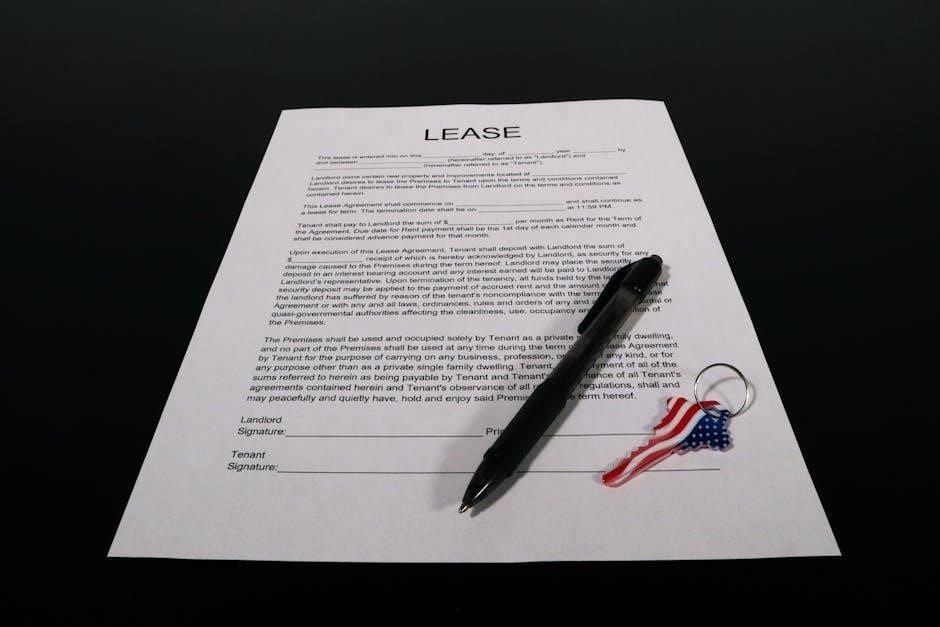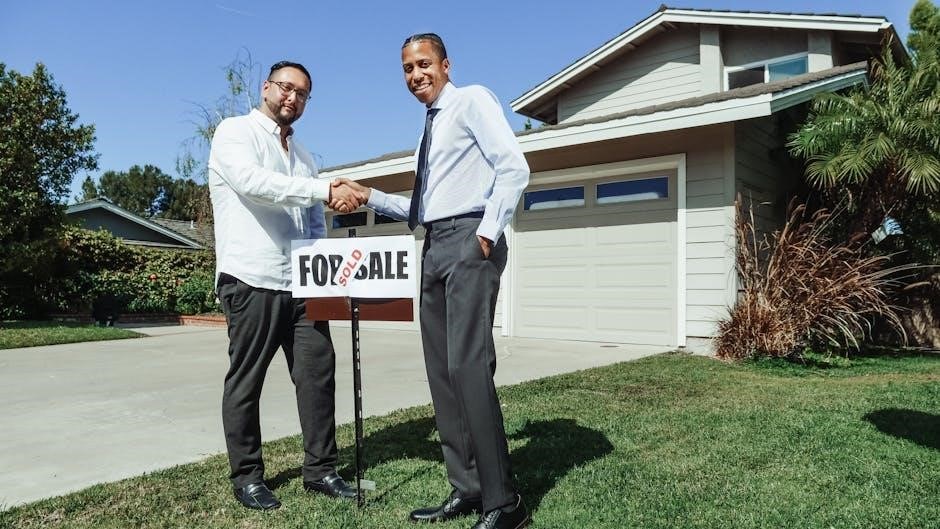Understanding Rent to Own Lease Agreements
A Rent to Own Lease Agreement is a contractual arrangement allowing tenants to rent a property with the option to purchase it during or after the lease term. It combines a standard lease with a purchase option, providing tenants a pathway to homeownership while enabling landlords to secure consistent rental income. This agreement is ideal for individuals who cannot immediately secure a mortgage, offering flexibility and financial preparation time. The lease term typically ranges from one to three years, with a portion of the rent often applied as a credit toward the purchase price. It’s a win-win solution for both parties, balancing rental stability with future ownership potential.
What is a Rent to Own Lease Agreement?
A Rent to Own Lease Agreement is a hybrid contract combining a rental agreement with an option to purchase the property. It allows tenants to rent a property with the possibility of buying it in the future, often within a specified period. A portion of the monthly rent may be applied as a credit toward the purchase price, helping tenants build equity. The agreement outlines the terms, including the purchase price, lease duration, and responsibilities of both parties. It differs from a standard lease by incorporating a purchase option, making it a flexible path to homeownership for those who may not immediately qualify for a mortgage.
How Rent to Own Lease Agreements Work
Rent to Own Lease Agreements function by combining a rental contract with an option to purchase the property. A tenant pays monthly rent, with a portion sometimes applied as a credit toward the purchase price. The agreement specifies the lease duration, purchase option terms, and the property’s sale price. Tenants can exercise the option to buy the property at a predetermined price during or after the lease term. If they choose not to buy, the option expires, and the landlord retains the property. This arrangement allows tenants to test ownership while building equity, offering a pathway to homeownership without immediate mortgage obligations.

Types of Rent to Own Agreements
Rent to Own Agreements are categorized into Lease-Option and Lease-Purchase agreements. Lease-Option gives tenants the right to buy, while Lease-Purchase obligates them to purchase the property.
Lease-Option Agreements
A Lease-Option Agreement grants tenants the exclusive right to purchase the property during the lease term. It includes an option fee and specifies the purchase price. A portion of the rent may be applied as a credit toward the down payment. This arrangement provides flexibility, as tenants can choose to buy or walk away at the end of the lease. It’s ideal for those needing time to improve finances or for landlords seeking stable tenants. The agreement outlines terms like the lease duration, rent payments, and purchase conditions, ensuring clarity for both parties.
Lease-Purchase Agreements
A Lease-Purchase Agreement obligates the tenant to buy the property at the end of the lease term. Unlike lease-option agreements, this arrangement requires the tenant to commit to purchasing the property. The lease term typically ranges from one to five years, with a predetermined purchase price agreed upon upfront. A portion of the monthly rent payments may be credited toward the down payment. If the tenant fails to complete the purchase, they may face penalties; This agreement is ideal for tenants who are certain they want to own the property and need time to secure financing or improve their financial situation.
Pros and Cons of Rent to Own Agreements
Rent-to-own agreements offer tenants a pathway to homeownership without immediate mortgage requirements, while providing landlords with stable income. However, they can be costly and complex, with risks of losing deposits or credits if tenants default or decide not to purchase. Both parties must carefully weigh the benefits and drawbacks based on their financial goals and circumstances.
Advantages for Tenants
Rent-to-own agreements provide tenants with a pathway to homeownership without immediate mortgage qualifications. A portion of monthly rent is often applied as credit toward the purchase price, reducing the financial burden. Tenants gain time to improve credit scores or save for a down payment while living in the property. This arrangement also allows tenants to test the property and neighborhood before committing to ownership. Additionally, it offers flexibility for those who cannot secure a mortgage immediately but aspire to own a home in the future. This option is particularly beneficial for individuals needing time to stabilize their financial situation.
Drawbacks for Tenants
While rent-to-own agreements offer benefits, they also present risks for tenants. Monthly payments are often higher than standard rentals, and a portion may go toward the purchase price, which could be lost if the tenant cannot secure financing. Additionally, tenants may still be responsible for property maintenance, typically the landlord’s duty. If the tenant decides not to purchase the property, they may forfeit the option fee and any accumulated credits. Some agreements lack flexibility, and breaking the lease early can result in financial penalties. Tenants must carefully weigh these potential downsides before committing to a rent-to-own arrangement.
Advantages for Landlords
Rent-to-own agreements offer landlords stable rental income and a potential sale opportunity. Tenants often treat the property with care, as they plan to purchase it, reducing maintenance costs. Landlords may charge higher rent and a non-refundable option fee, ensuring financial gain even if the tenant doesn’t buy. Attractive to tenants who can’t secure a mortgage, these agreements minimize vacancy risks. Landlords retain ownership until the purchase, allowing them to sell without realtor fees. This arrangement provides steady cash flow and a potential sale, making it a beneficial option for property owners seeking long-term financial stability and tenant reliability.
Drawbacks for Landlords
While rent-to-own agreements offer benefits, landlords face potential downsides. If tenants default or walk away, landlords must restart the rental or sales process, losing time and potential income. Option fees and rent credits may be forfeited, reducing financial gains; Tenants might negotiate lower purchase prices, impacting landlords’ profit margins. Additionally, landlords remain responsible for property taxes and maintenance until ownership transfers. If the tenant damages the property, landlords could incur repair costs. These risks highlight the importance of careful tenant screening and clear contractual terms to mitigate potential losses and ensure a smooth transaction.

Key Components of a Rent to Own Lease Agreement
A rent-to-own lease agreement includes the lease term, purchase option details, rent structure, payment terms, and responsibilities of both the landlord and tenant, ensuring clarity and mutual understanding.
Essential Terms and Conditions
A rent-to-own lease agreement must clearly outline lease duration, purchase option details, rent structure, and payment terms. It should specify the purchase price, rent credits, and responsibilities for property maintenance. The agreement should also define default terms, termination clauses, and option fees. These terms ensure both parties understand their obligations and rights, providing a legally binding framework for the rental and potential purchase process. Clarity in these terms is crucial to avoid disputes and ensure a smooth transaction. Proper documentation is essential for enforcing the agreement.
Additional Items to Include
Beyond the basic terms, a rent-to-own lease agreement should include property condition disclosures, inspections requirements, and maintenance responsibilities. It should outline insurance obligations, tax responsibilities, and liability clauses. Including addendums for local laws and disclosures ensures compliance with regulations. A separate addendum for the purchase option details, such as the exercise process and timeframes, is also crucial. These items provide transparency and protect both parties, ensuring all aspects of the agreement are legally sound and mutually understood. Proper documentation prevents future disputes and clarifies expectations for both tenant and landlord.

The Process of Creating a Rent to Own Agreement
Creating a Rent to Own agreement involves outlining lease terms, defining the purchase option, including legal clauses, and ensuring compliance with local laws. Use a template or consult a lawyer to draft the agreement, covering rent, duration, property details, purchase terms, and penalties for breaches. Negotiate terms between landlord and tenant, ensuring clarity on rent credits, purchase price, and contract forfeiture. Ensure the agreement complies with state regulations and includes necessary disclosures. This structured approach protects both parties, facilitating a clear and legally sound transaction.
Step-by-Step Guide to Drafting the Agreement
Begin by outlining the lease terms, including duration, rent amount, and payment terms. Define the purchase option, specifying the price and conditions for exercising it. Include details about rent credits and how they apply to the purchase price. Add clauses for property maintenance, repairs, and tenant responsibilities. Consult local laws to ensure compliance. Use a template or hire a legal professional to draft the agreement. Clearly outline penalties for defaulting on the lease or purchase option. Ensure both parties sign and date the document, with witnesses if required. Finally, execute the agreement and provide copies to both landlord and tenant for legal records.
Negotiating Terms and Conditions
Negotiating a Rent to Own Lease Agreement requires clear communication between the landlord and tenant. Key areas to negotiate include the lease duration, monthly rent, purchase price, and rent credit applied toward the purchase. Both parties should agree on maintenance responsibilities, repair costs, and the conditions under which the tenant can exercise the purchase option. It’s essential to clarify penalties for defaulting on payments or failing to complete the purchase. Ensure all terms are mutually beneficial and clearly outlined to avoid future disputes. Legal advice is recommended to safeguard both parties’ interests and ensure compliance with local laws.
Legal Considerations and Risks
Rent-to-own agreements involve legal risks for both parties, including contract enforceability, disclosure requirements, and potential disputes over property condition or payment defaults. Legal advice is crucial to mitigate risks.
Legal Implications for Landlords
Landlords must ensure rent-to-own agreements comply with local laws, including fair housing and tenant rights regulations. Clear terms regarding rent, purchase options, and property condition are essential to avoid disputes. Landlords may face legal risks if agreements are deemed unfair or incomplete. Proper documentation and adherence to eviction laws are critical if tenants default. Consulting legal counsel is recommended to draft enforceable contracts and protect property rights. Non-compliance can lead to financial losses or legal penalties, emphasizing the need for thorough preparation and understanding of legal obligations in rent-to-own arrangements.
Legal Implications for Tenants
Tenants in rent-to-own agreements must understand their legal obligations, including timely rent payments and maintaining property condition. They risk losing deposit credits or option fees if they default. Tenants should carefully review lease terms to avoid unexpected penalties. Understanding local tenant rights and eviction laws is crucial. If the landlord breaches the agreement, tenants may have legal recourse. Consulting a legal expert can help navigate complexities and ensure rights are protected. Tenants must also be aware of their financial commitments and the consequences of failing to exercise the purchase option within the agreed term.

Rent to Own Agreement Templates
Rent-to-own agreement templates are widely available online, offering customizable solutions for landlords and tenants. They ensure legal compliance and streamline the lease-to-purchase process effectively.
Free Rent to Own Agreement Templates
Free rent-to-own agreement templates are readily available online, offering customizable solutions for landlords and tenants. These templates provide a structured format to outline lease terms, purchase options, and rent credits. They often include sections for property details, payment terms, and tenant responsibilities. Downloadable in Word or PDF, these templates ensure compliance with local laws and simplify the creation of legally binding contracts. By using a template, both parties can avoid costly legal fees and ensure clarity in their agreement. Free templates are a practical tool for facilitating smooth rent-to-own transactions.
Customizing the Template for Specific Needs
Customizing a rent-to-own lease agreement template ensures it aligns with the unique requirements of both landlords and tenants. Start by including property details, such as the address and description. Specify the lease duration, monthly rent, and the portion applied as a rent credit toward the purchase price. Outline tenant responsibilities, maintenance obligations, and purchase terms, including the agreed-upon price and closing process. Additionally, incorporate state-specific legal requirements to ensure compliance. Customization allows both parties to tailor the agreement to their circumstances, creating a clear and binding contract that addresses all aspects of the rent-to-own arrangement.